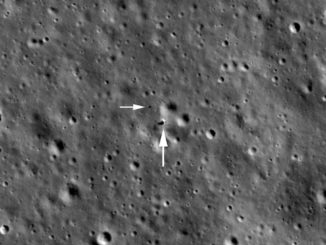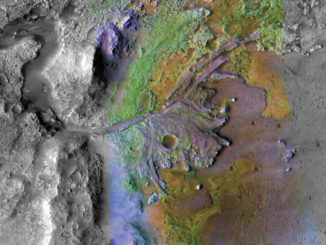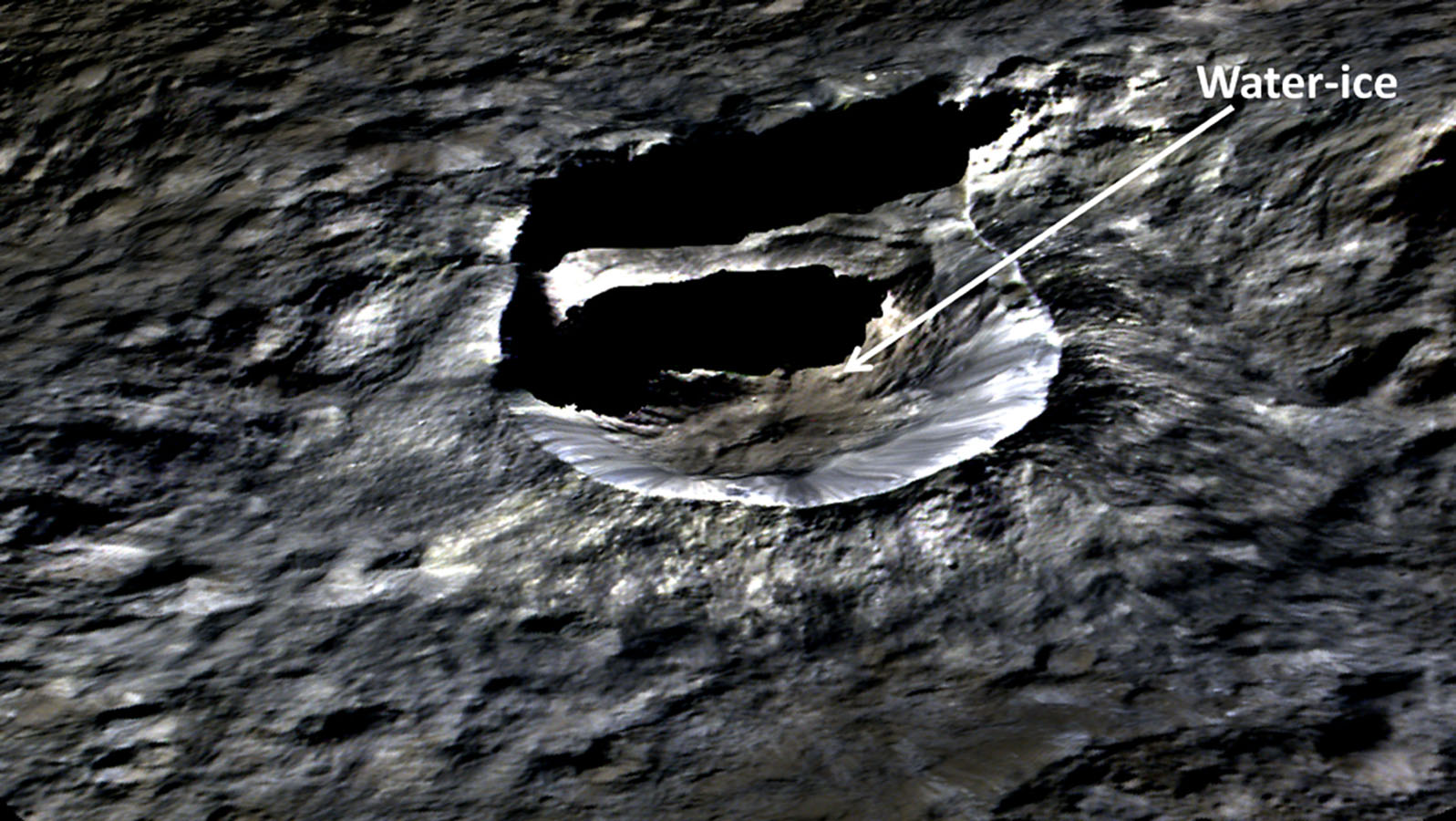
NASA’s Dawn spacecraft has continued its survey of the dwarf planet Ceres this year, discovering rock-bound ice hidden just beneath the airless world’s rugged surface and a handful of icy outcrops inside craters in the northern hemisphere, raising hopes that Ceres could have once held a buried habitable ocean of liquid water.
Dawn does not carry instruments to probe for water deep underground, but the mission’s examination of Ceres’s surface properties point to a watery presence at some point in the dwarf planet’s history.
“Liquid water had to be in the interior of Ceres in order for us to see the mineralology that’s on the surface — the phyllosilicates (clay minerals) — and also the concentration of the hydrogen that we see in the equator that’s presumed to be ice-free,” said Thomas Prettyman, lead scientist on Dawn’s Gamma Ray and Neutron Detector, or GRAND, instrument from the Planetary Science Institute in Tucson, Arizona.
“So Ceres’s surface, the fact that it’s ice-rich, and that there are alteration products on the surface, means that at some point in time there was liquid water,” Prettyman said in a Dec. 15 press conference at the American Geophysical Union’s fall meeting in San Francisco.
Circling around the sun inside the asteroid belt between the orbits of Mars and Jupiter, Ceres formed from a collection of pebbles and dust in the proto-solar system around 4.5 billion years ago, likely farther from the sun thats its current location, giving it a heritage closer to the moons of the outer solar system than most asteroids.
“We’re interested in what was happening right after Ceres accreted, and we’re mostly interested in whether the water and volatiles separated from the granular material, created a subsurface ocean, and the water and rock interacted in ways that would have produced a chemical environment which would have been conducive to life, a habitable environment,” said Carol Raymond, the Dawn mission’s deputy principal investigator from NASA’s Jet Propulsion Laboratory in Pasadena, California.
Ceres likely lost its supposed liquid ocean more than 2 billion years ago, Raymond said. Before that point, Ceres might have been much like Jupiter’s moon Europa or Saturn’s moon Enceladus, two hot spots in the ongoing search for microbial life in the solar system.
If an ocean was under Ceres’s surface, it froze as the dwarf planet cooled billions of years ago, when its internal natural radioactive heating source decayed. Europa and Enceladus are subjected to tidal heating from the strong gravitational pull from Jupiter and Saturn, and thus retain their liquid oceans today.
“When Ceres froze out would have been likely fairly early on … within a couple billion years of its accretion, so before the freezing part, if there was substantial water-rock fractionation, and there was a substantial water ocean, then all of these chemical processes that were occurring that were creating the phyllosilicates (clays) we see would have provided the energy and the environment that would have been conducive to life,” Raymond said. “So I think it’s pointing toward Ceres being an interesting object, mostly equivalent to Europa or Enceladus in terms of its habitability potential.”
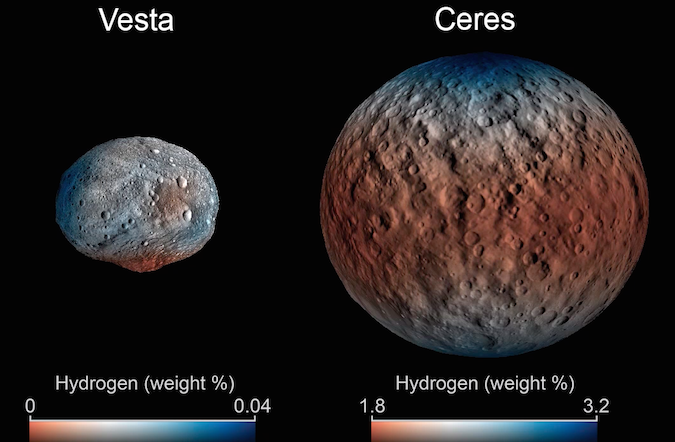
According to Prettyman, data from his team’s instrument show Ceres harbors a vast global reservoir of hydrogen, which scientists infer to be water, 100 times more than the hydrogen found at Vesta, a rocky asteroid visited by Dawn earlier in its mission.
Near the equator, the water seems to be bound to rocks, forming “hydrated” minerals likely embedded with organic molecules, Prettyman said. At higher latitudes, the hydrogen signal is stronger, consistent with large masses of water ice lurking just below the surface, perhaps as shallow as a few feet in some regions.
Dawn’s GRAND instrument works by collecting gamma rays and neutrons generated when galactic cosmic rays, which constantly stream into the solar system from interstellar space and strike Ceres’s surface. The incoming radiation strips neutrons from their atomic nuclei, then the neutrons produce gamma rays as a byproduct of nuclear reactions.
“The neutron emissions are sensitive to light elements like hydrogen and carbon that are in the surface,” Prettyman said. “The neutrons also undergo nuclear reactions and make gamma rays, and the gamma rays provide a fingerprint of what’s in the surface. You can kind of imagine that there’s a specific gamma ray energy that’s associated with a particular nuclear reaction. You know that energy, and you can identify the element that was struck by the neutron.”
Some water ice is even exposed on Ceres’s surface.
High-contrast, brightened images from Dawn’s German-built framing camera have helped scientists locate markings inside dark craters near the dwarf planet’s north pole. The mission’s Italian-built visible and infrared mapping spectrometer has determined at least one of the bright deposits is water ice, according to Norbert Schorghofer, a Dawn mission scientist from the University of Hawaii at Manoa.
Dawn’s science team has identified more than 600 “persistently shadowed regions” on Ceres, almost all at the bottoms of craters in the northern hemisphere, Schorghofer said. These locations never see sunlight throughout Ceres’s nine-hour day, even during the northern summer.

Brightened imagery showing the dark shadowed regions have revealed 10 have bright deposits, and one has an outcrop extending into sunlight, allowing Dawn’s spectrometer to measure the feature’s chemical composition, which turned out to be water ice.
Schorghofer said scientists assume the bright markings inside other shadowy craters are also made of water ice, which is able to survive on the surface in certain locations because the persistently shadowed regions are extremely cold, less than minus 260 degrees Fahrenheit (110 Kelvin), preventing the ice from turning into vapor and escaping.
These “cold traps” are similar to dark crater floors at the poles of Mercury and Earth’s moon.
“What’s common among these three airless bodies is that they all have very little seasonality, and a crater near the poles doesn’t see sunlight,” said Schorghofer, co-author of a paper describing the persistently shadowed craters in the journal Nature Astronomy. “Ceres helps us put the cold traps of Mercury and the moon in context.
“On Mercury, the cold traps are basically filled with ice,” Schorghofer said. “On the moon, the situation is very complex. There doesn’t seem to be much exposed ice at least. On Ceres, there is ice in at least some cold traps.”
Dawn’s spectrometer has also found probable water ice inside Oxo crater, a small sunlit impact basin at Ceres’s mid-latitudes.
“There is lots of ice beneath the surface, very close to the surface, but it’s rare on the surface,” Schorghofer said. “Subsurface ice is ubiquitous on Ceres. Exposed ice is rare.”
Scientists are still studying how the water molecules ended up in Ceres’s northern crater floors.
Europe’s Herschel space telescope detected water vapor at Ceres in 2012 and 2013, a finding that might mean the icy world supports a tenuous atmosphere. Dawn’s GRAND instrument has also returned data suggestive of an ultra-thin atmosphere, which would help explain how water could be transported around the dwarf planet, and fall into the cold traps.
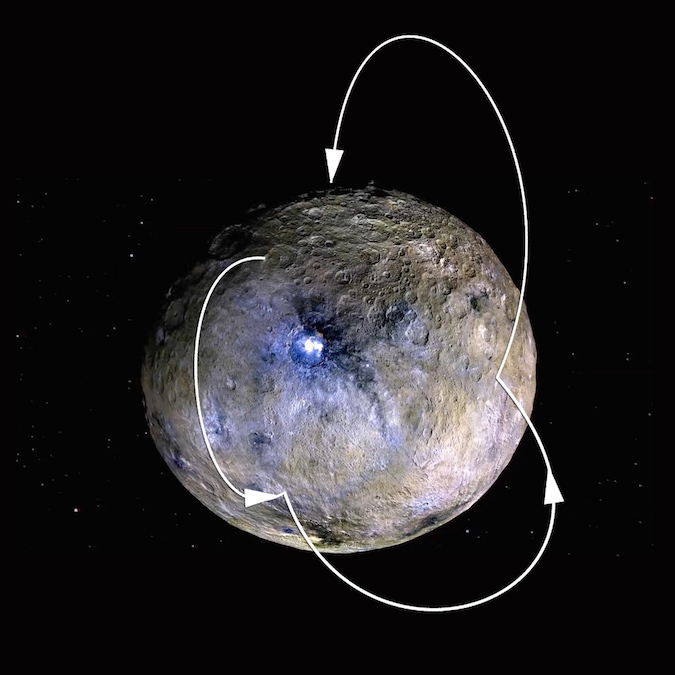
“If, for whatever reason, there is a water molecule on the surface, it will undergo these giant hops, which take over an hour, and a fraction of them will just happen to fall into these cold traps,” Schorghofer said. “We think that’s how the ice accumulates.”
Some scientists hoped to find more extensive ice at Ceres’s surface, and were initially buoyed by the discovery of large bright spots inside several craters, most prominently the Occator crater, that turned out to be salt deposits.
The signature of carbonates, a type of salt, inside the 57-mile-wide (92-kilometer) Occator crater has left experts trying to learn how the deposits got there.
Ralf Jaumann, a planetary scientist and Dawn co-investigator from Germany’s DLR space agency, said one leading theory are that the impactor that excavated Occator created a pool of melted rock and water, an impact-driven hydrothermal system that separated different chemicals in the aftermath of the cosmic smash, leaving behind the salt slabs at the surface.
“Another idea is that we have (watery) material beneath the surface, which has been released by the impact itself,” Jaumann said. “So the impact triggered cryovolcanic activity. There’s an open debate about this. It’s not clear how this works.
There still may be water underneath the bright salty features in Occator, which have been named Cerealia Facula and Vinalia Faculae. The central deposit has a fractured salt dome.
“I’m pretty sure that there’s also water in Occator in the subsurface,” Jaumann said. “The problem we have is all of our instruments are not able to penetrate the surface. We just get the first millimeters of the surface in our data.”
A mountain on another part of Ceres, named Ahuna Mons, is an example of a more recent cryovolcano. The peak, towering more than 15,000 feet (5 kilometers) above nearby terrain, is no longer erupting, but scientists believe it only went dormant in a relatively recent era of geologic history, perhaps as little as a few hundred million years ago.
Ahuna Mons likely spewed out a mixture of water, salt and mud that flowed down its slopes.
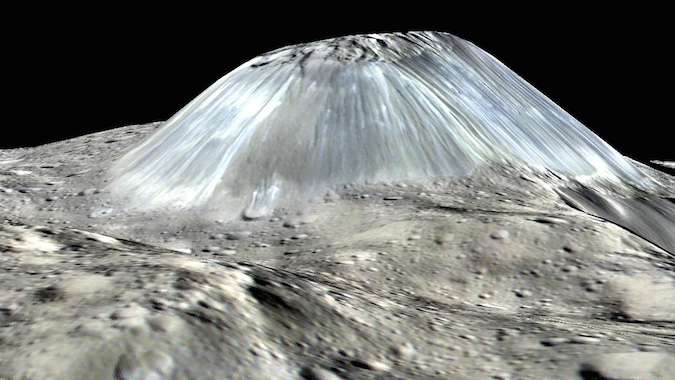
The geologic activity … does tell us that there are likely some liquids in the subsurface,” Raymond said. “Whether we have water is unclear because what we would expect is briny fluid (very salty water). They have a much lower melting temperature than water, so the water likely is sequestered in the ice deposits near the surface, and if there are fluids, they mostly likely are very brine-rich fluids and they would account, for instance, the Ahuna Mons features that is interpreted to be a cryovolcano.”
NASA approved funding for Dawn to continue its exploration of Ceres earlier this year, opting to keep the spacecraft in orbit around the dwarf planet instead of sending the probe on a flyby of asteroid Adeona, a main-belt asteroid believed to be a primitive, carbon-rich body left over from the earliest history of the solar system.
Dawn is now monitoring Ceres for any changes as the dwarf planet, which is the largest object in the asteroid belt, nears perihelion, the closest point to the sun in its orbit.
The spacecraft launched in September 2007, and was the first probe to orbit two extraterrestrial worlds — Vesta and Ceres — using highly-efficient ion thrusters to bend its trajectory through the solar system.
Dawn arrived at Ceres in early 2015 and is now orbiting about more than 4,500 miles (7,200 kilometers) above Ceres after raising its altitude to conserve fuel.
Two of the spacecraft’s four reaction wheels failed earlier in the mission, forcing engineers to improvise a “hybrid” system using the remaining wheels and hydrazine-fueled rocket thrusters to control Dawn’s pointing for science observations and propulsive maneuvers.
The unexpected consumption of hydrazine led to estimates that the probe may run out of fuel soon after completing its primary mission at Ceres earlier this year, but Raymond said the two active reaction wheels, gyro-like devices which turn the spacecraft with momentum, remain healthy.
“The fact that they have survived means we’ve used about half the hydrazine we would have had to use without them,” Raymond said, referring to the reaction wheels. “That’s one of the reasons why Dawn has continued to operate, and those wheels are doing fine.
“We’re not using much fuel right now because we’re farther away from Ceres, but as long as they survive, the prospects for continuing to operate are pretty good throughout the next year.”
Email the author.
Follow Stephen Clark on Twitter: @StephenClark1.

